#italian witchcraft
Text
Roman mythology
like many ancient mythologies, includes a diverse array of gods and goddesses, each with their unique attributes and roles. The Roman gods and goddesses were often adapted from Greek deities and other ancient cultures.
Here are some of the major Roman goddesses:
1. Juno: Juno was the queen of the gods and the goddess of marriage, childbirth, and women. She was the wife of Jupiter (the Roman equivalent of Zeus). Juno was often depicted as a regal woman, wearing a diadem and holding a scepter. She was also associated with the protection of the Roman state.
2. Minerva: Minerva was the goddess of wisdom, strategy, and warfare. She was the Roman equivalent of the Greek goddess Athena. Minerva was considered to be a virgin goddess and was often depicted wearing a helmet and carrying a shield and spear. She was also associated with arts, crafts, and education.
3. Venus: Venus was the goddess of love, beauty, and fertility. She was the Roman counterpart of the Greek goddess Aphrodite. Venus was often depicted as a beautiful woman and was closely associated with the city of Rome. She had a son named Cupid, the god of love, who played a significant role in Roman mythology.
4. Diana: Diana was the goddess of the hunt, the moon, and nature. She was the Roman equivalent of the Greek goddess Artemis. Diana was often depicted as a young woman carrying a bow and arrow and accompanied by a deer or hunting dogs.
5. Vesta: Vesta was the goddess of the hearth, home, and family. She was the guardian of the sacred fire in the Roman Forum, which represented the hearth of Rome. Vesta was depicted as a veiled woman, symbolizing the importance of her role in protecting the household.
6. Ceres: Ceres was the goddess of agriculture, crops, and fertility. She was often associated with the growth of grain and the earth's abundance. Ceres played a significant role in Roman religious festivals, especially during the harvest season.
7. Fortuna: Fortuna was the goddess of luck, fortune, and fate. She was often depicted with a cornucopia and a wheel, symbolizing the unpredictable nature of fortune. Fortuna was both feared and revered, as her actions could bring either good or bad luck.
8. Proserpina: Proserpina (also known as Persephone) was the daughter of Ceres and the queen of the Underworld, having been abducted by Pluto (the Roman equivalent of Hades). She represented the changing seasons, as her departure to the Underworld brought about winter, and her return to the world of the living heralded the arrival of spring.
These are just a few of the numerous Roman goddesses, each with their unique stories, symbols, and cultural significance. Roman mythology is a fascinating world filled with rich narratives and complex characters, reflecting the beliefs and values of ancient Roman society.
#Roman goddesses#Roman mythology#witchblr#witchcore#witchcraft#witchlife#white witch#beginner witch#witch tips#grimoire#spirituality#italian witch#italian magick#italian witchcraft#italian folk magick#book of shadows
340 notes
·
View notes
Text
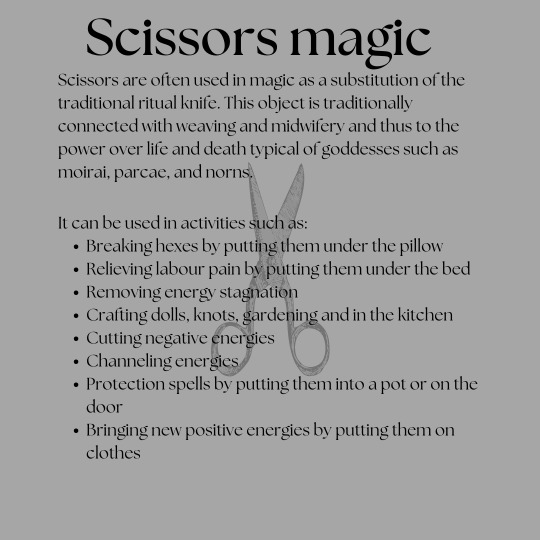
Scissors symbolize cutting, separation, and liberation. Many cultures use scissors to cut hair, cloth, or paper as a symbolic act of letting go of the past or starting fresh.
They can represent the power to create, the ability to cut through obstacles, and even the transformation of the self. In italian witchery scissors have a main role in removing the malocchio, the evil eye, and in bringing new positive energies into the house.
#witchcraft#witchblr#witches of tumblr#scissors magic#magic basics#magical tools#babywitch#scissors#paganism#stregheria#italian witchcraft#italianwitch#strega#italian traditions#traditional witchcraft
75 notes
·
View notes
Text
It’s been a while since I’ve written something here (thanks covid! Im still facing a few difficulties due to this bad b***), so why not resume to make posts again?
I wanted to share a little thing I did to myself to bring with me my altar’s energies and influeces: a Witch pouch!
So yes, the main items I used were:
- Selenite (crystal with lunar attunement, known as an energy cleanser, powerful stone of luck and protection)
- Pine cone (to represent the one onto the Thyrsus, Dionysus’ staff, a symbol of prosperity, fertility, and hedonism)
- A charm depicting Diana (just in case..)
- Mugwort (a herb I’m strongly bond to, but besides that, a herb associated with Diana herself, with the moon, with the feminine)
- A hagstone/“Diana’s stone” (as Charles Godfrey Leland writes in the “Aradia, Gospel of the Witches”: because finding a holed stone meant that the finder has Diana’s favor)
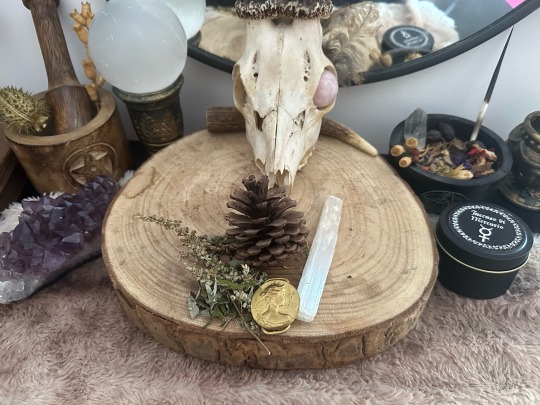

Also, I know it’s unrelated but can I say how much I love this pouch? I got it from a vintage market, it was a 60s-70s fabric belt’s container, the belt has the very same black velvet + decorations (sharing a picture of that as well!), that reminds me of Black Henbane flowers 🖤
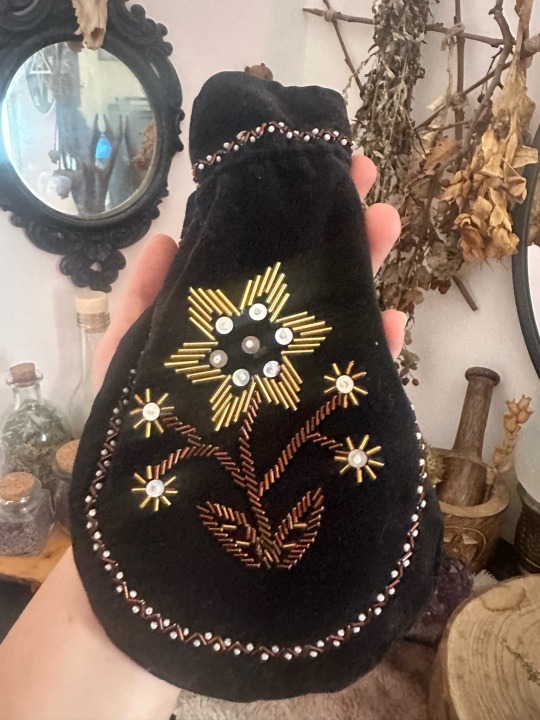
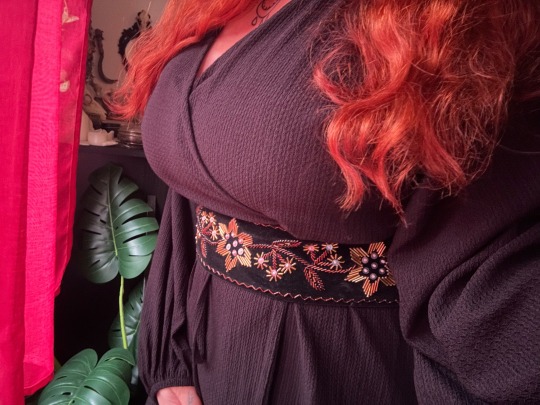
#witch#witchcraft#pagan#witchy#magic#personal#traditional witchcraft#magick#stregheria#strega#witchy woman#pagan witch#diary#diary entry#diana#Diana venatrix#Italian witch#Italian witchcraft#Italian traditional witch#Roman pagan
99 notes
·
View notes
Note
Hello! I am just starting my journey on reconnecting with my traditional roots as an Italian practitioner. My great grandparents came from Italy in the mid 1900s, but unfortunately passed before I had the pleasure of asking about their practices. Can I ask a good starting point for someone who is trying to reconnect all on her own?
Hello!
I am so happy that you are wanting to reconnect with your roots! I'm sorry you didn't get the opportunity to ask your grandparents, my deepest condolences for your loss.
In terms of resources, my recommendation for anyone starting out is to go to folklore sources or to read books by authors who don't simply reference other witchcraft authors. I highly recommend reading Italian Folk Magic: Rue's Kitchen Witchery by Mary-Grace Fahrun. It's mostly her personal experience with Italian folk-Catholicism and magic with plenty of anecdotes, recipes, superstitions, and various rituals. I think it's probably the best widely available source out there. She also has a youtube channel! In a similar vein, the website Italian Folk Magic has some great posts about Southern Italian and Sicilian magic.
Other online resources I've found useful are Gail Faith Edwards' writings on Southern Italian healers and folk medicine (it's split into 2 parts–– there's a lot of great information if you're into herbalism/ green witchcraft). I also love this article detailing witchcraft history, superstition, and more throughout Italy. It goes into a lot of detail and has some information about herbal properties and their uses as well.
Here are some festivals and traditions from across Italy tied to folk belief: Focara of Novoli, The Campanacci in Basilicata, The Feast of San Domenico and the Ritual of Serpari of Cocullo, Naca Procession in Southern Italy, Dance of the Devils, Celebration of Santa Lucia, The Feast of Mamma Schiavona––There are many others (mostly Saint feasts) that have pre-Christian roots or have significant rituals attached.
Most information that I have collected comes from anthropological and folklore sources that aren't very accessible. There are some videos available of documentary footage of Italian anthropologist Ernesto de Martino's work detailing folk tradition: here's a clip of La Taranta. This documentary isn't in English, however you can still get a lot out of it even if you don't speak Italian (unfortunately there are no subtitles). The documentarian that worked with de Martino, Luigi Di Gianni gives some of his recollections here. Here is a clip documenting the Feast of Mamma Schiavona. Otherwise, everything else is behind a paywall on sites like jstor, sagepub, and other academic publishers. I would recommend reading anything by anthropologist and folklorist Sabina Magliocco (I have copies of her work), as well as de Martino's Magic: A Theory from the South (which I also have a pdf of). The academic texts can be a little dense and daunting, but they're worth the read.
I have uploaded some of what I have to WeTransfer, but it will only be up for 1 week (until July 10th) so if anyone else would like to download them, you can for a limited time!
#italian folk magic#folk magic#folk traditions#witchcraft#beginner witch#baby witch#witchblr#italian witchcraft#grimoire#book of shadows#streghe#stregoneria#benedicaria#witch tips#long post#witches of tumblr
89 notes
·
View notes
Text



#book of shadows#grimoire#italian witchcraft#stregheria#witchcraft#witch#art#black magic#occult#dark art#dark aesthetic#witchblr#witches#witchcore#💋
15 notes
·
View notes
Text

#stregheria#italian witchcraft#book of shadows#grimoire#witchcraft#witch#art#witchblr#witches#witchcore#witch community#witch aesthetic#occult#coven#covenant#Spotify
11 notes
·
View notes
Text
Happy Mabon! Happy Autumnal Equinox! Happy 23th September! Happy Ostara (southern hemisphere)!
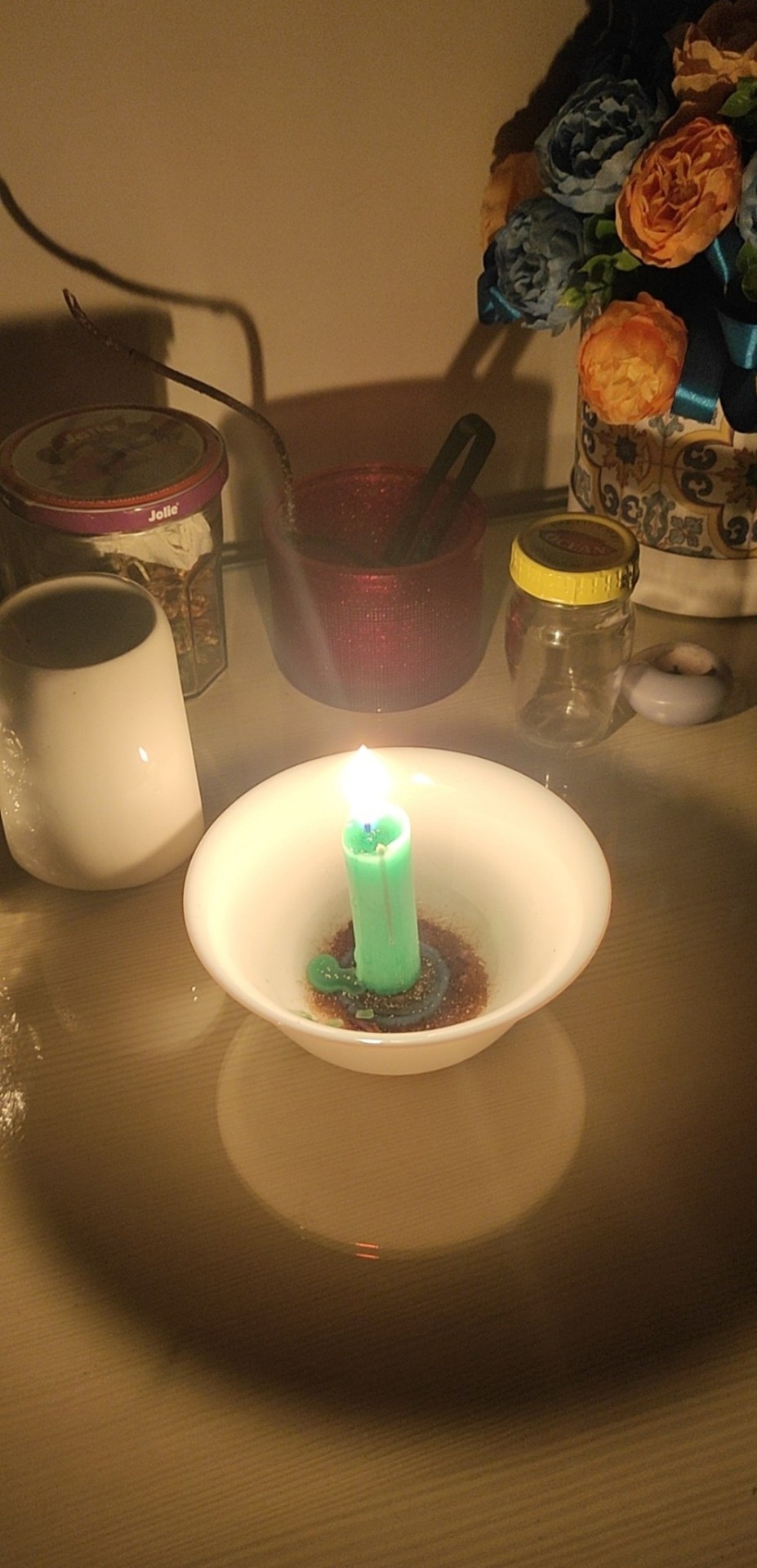
I spent the day resting and the night drinking hot tea with my dearest friends. To celebrate this seasonal change I also baked apples with cinnamon and cloves and I lit a candle the 21th, today and I will light another one the 25th.
May you feel rested, may you share your harvest with your loved ones, may you collect your achievements and have an abundance of love and peace.
Blessed be, as one with nature breathing under the Moon.
🌒🌕🌘
#strega herbana#witchblr#green witch#witch blog#green witchcraft#plantblr#witch#witchcraft#mabon#italian witchcraft#italian witch#autumn equinox#fall equinox#equinox#candles#candle magic#ground cinnamon#cloves#wicca#wiccan#pagan wicca#wiccablr#wicca aesthetic#witchy things#eclectic witch#witches of tumblr#everyday magic#mabon 2023#mabon altar#ostara
51 notes
·
View notes
Text
Do you have a Book of Shadows? I wish mine was as beautiful as this!

#witch blog#pagan blog#pagan stuff#witchblr#pagans of tumblr#witch community#paganblr#paganism#pagansofinstagram#pagan#book of shadows#eclectic witch#witchy#witch#italian witchcraft#witches#witchcraft#witch aesthetic#witchy vibes#witchcraft community#witches of tumblr#witches of the world
16 notes
·
View notes
Text
Uhm... I'm being active again in my witchy and spiritual ways too! So it should be about the time in which I'm actively searching for new wonderful blogs and people to interact with. So, can you interact or reblog if you:
Are a European witch (both born in the Eu or from European families elsewhere);
A Gaelic polytheist;
An Italian witch (2nd, 3rd generation American-Italian are welcomed too, bruh, you are Italian as me!)
A polytheist who follows the Etrurian gods
A devotee of any God(s) (I'd like to interact more with devotees of any traditions!)
Have one or more spirit companions
Are an Otherkind (no matter your specific kind)
Have astral travel experience (of course beginners are welcome too!)
Have a connection with the spirits of the land in your place.
Are a witch or a spiritual practitioner of your faith (of any traditions and religions, It would be my honor to be enriched by others' experiences and cultures)
#etruscan#gaelic polytheism#witchblr#divination#spirituality#witch community#paganblr#polytheism#witches of tumblr#gaelic#italianwitch#italian witchcraft#spirit companions#astral travel#otherkin#animism#devotees#deity work#godspouse#psychic
110 notes
·
View notes
Text
Janarric Runes how to use
Origins
Connect with the runes
Sea offerings
Janaric Runes shell ritual
Janaric Runes-Sacred sea runes



The Janarric Runes
#sea runes#how to use janarric runes#janarric runes#connect with janarric runes#janaric rune shell ritual#sacred sea runes#sea witch#ocean witch#water witch#moon witch#book of shadows#mediterranean witch#witches of tumblr#witch community#sea offerings#italian witchcraft#italian witch
154 notes
·
View notes
Text

The time of death and ancestral reverence is here. Even though the time of honoring your ancestors is all year round, the fall and winter seasons are the time of death, and as the earths foliage dies and transforms we can see the change more and more each day.
The changes to the earth at this time of year are just like like the changes to the human body as death prepares you for your long journey.
Death and the dead are topics I have always been fascinated with. As a medium and trance channeler, I have always had a close connection to the dead and my ancestors. When my Gigi passed away a few years ago, I felt even closer to the spirit world than ever.
The pictures above are of my Grandmother, it shows the stages of her life until the end. How the slow but inevitable decline changed her form, demeanor, and personality.
My grandmother was a strong loving and caring Neapolitan American Woman, and she is the one who taught me how to love.
Working with the Ancestors is a huge part of my practice and life. If you are new to working with ancestors or you would like to get and idea on how an Italian American Folk Witch honors and works with her ancestors then join me for my new class Saturday October 21 at 7pm.
# samhain # halloween # ancestralveneration # ancestralwisdom # ancestralmagic # folkmagic # mabon # autumnequinox # witchcraft # ancientmedicine # ancestors # ancestralhealing # witchesofinstagram # halloweenmagic # streghe # stregheitaliane # stregoneria # stregoneriaitaliana # janare # janara # majare # majara
#melungeon#halloween#samhain#ancestors#ancestral#spirits#ancestral healing#italian folk medicine#italian#italian folk magic#folklore#pyrenees witches#french folk magic#folk magic#irish#irish witch#italian witchcraft#irish witchcraft#halloweenmagic#streghe#strega#stregoneria#stregheitaliane#Janare#janara#majare#majara#witchcraft#witchblr#autumn equinox
8 notes
·
View notes
Text
Italian folk magic - Increase wealth spell
Italian folk magic encompasses a variety of traditional practices and beliefs, including spells aimed at increasing wealth and abundance. I am sharing these generational family spells in hopes to spread knowledge & help to educate beginner folk magic witches / practitioners.
Here's a simple Italian folk magic spell that focuses on attracting financial prosperity:
Materials needed:
- A small green candle
- Olive oil
- A pinch of basil
- A piece of paper
- A pen or pencil
- A small dish or bowl
Instructions:
1. Begin by preparing your workspace. Find a quiet area where you can perform the spell without distractions.
2. Take the green candle and anoint it with olive oil. As you do so, visualize money and abundance flowing towards you. Feel the sense of financial security and freedom.
3. Sprinkle a pinch of basil onto the anointed candle, symbolizing growth and prosperity.
4. Place the candle in a holder and light it, focusing your attention on the flame. Imagine it radiating energy and attracting wealth into your life.
5. Take the piece of paper and write down your financial goals and aspirations. Be specific and clear about what you want to achieve. Visualize yourself already enjoying the abundance and prosperity you desire.
6. Fold the paper and place it in the dish or bowl in front of the candle.
7. As the candle burns, say the following incantation or create your own words:
"By the candle's vibrant glow,
I call upon abundance to flow.
Wealth and riches come to me,
As I will, so mote it be."
8. Sit quietly for a few moments, focusing on your intention and the energy you've raised. Feel gratitude for the financial blessings that are on their way to you.
9. Allow the candle to burn completely or extinguish it if you need to leave the area. If you decide to extinguish it, relight the candle when you return until it burns out completely.
10. Keep the folded paper in a safe place, such as a wallet or a drawer, to reinforce your intention and remind yourself of your financial goals.
Remember, while spells can be a meaningful way to focus your intention and energy, they should be seen as tools for empowerment and manifestation. It's important to also take practical actions and make responsible financial decisions to support your goal of increasing wealth.
#italian folk magic#italian witchcraft#italian folk magick#witchblr#witchcore#witchcraft#witchlife#beginner witch#italian witch#witch tips#grimoire#spirituality#book of shadows#italian wealth spell
212 notes
·
View notes
Text
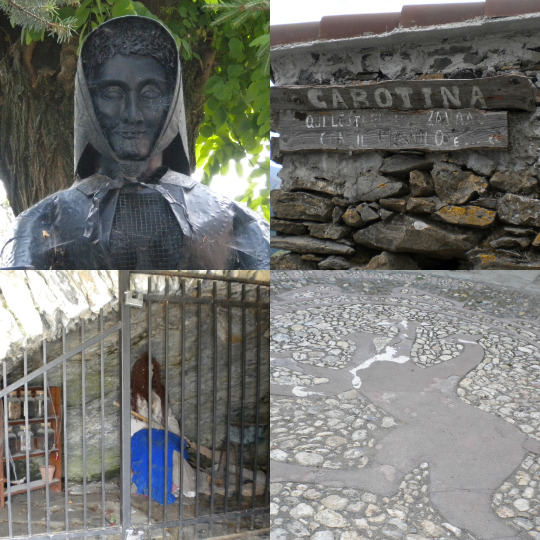
Italian witch trials
Triora is a small village located in the region of Liguria in Italy, the town is known as the “Italian Salem” because of the famous Witch’s trial occurred there in the 16th century.
It was 1587 when after two years of famine the village leaders and the elder’s council decided that such a tragedy was the result of the evil doing of a bunch of local women, all accused of mingling with the devil. The accused women were mainly prostitutes or poor women emarginated in the Cabotina, a district populated by meager people located outside the town walls.
Nobody complained when a bunch of wretched women without a penny were accused of witchcraft, but things quickly changed when the accusations spread like oil and invested the wealthier women of Triora’s society.
Genoa sent over to Triora Giulio Scribani, a former local magistrate, nominated special commissioner for the case. Scribani sent thirteen women to the prison of Genoa and raged throughout the area opening new cases and causing innocent women to die. Genoa, the Inquisition, and the Church itself tried to intervene and to stop the trials but Scribani went ahead; in Triora and neighboring villages such as Andagna, Bajardo, and Montalto Ligure the deaths of many innocent people were recorded.
In 1589 after two years of persecutions the trials were closed by the Inquisition, little is known about what happened to the women that were sent to Genoa, but dozens were the women imprisoned, and those who did not burn to death, died from the torture they endured.
Historians agree in saying that the reasons behind the accusations, were possibly that local landowners wanted to rise food prices to increase their income causing people to become unable to buy food to sustain themselves and their families. Blaming the death of hunger-stricken people on witchcraft was a perfect way out.
Today the town honor the memory of the events with a museum dedicated to the witch hunt, trials and witchcraft, but the geographic area is still connected with its mysterious and magical past.
The heraldry symbol of the town is Cerberus, the infernal hound, the name Triora in fact comes from the Latin Tria Ora which means three mouths. Triora’s main church, the Collegiata it’s believed to be constructed on a previous pagan temple, a Fanum. Evidence of earlier pagan cults is also represented by an ancient menhir situated in the Mezzaluna Pass. But the area is full of places considered witching spots, natural spaces where it’s believed that withes organized their sabbaths, like the lake Lagodégnu, the field Ciàn der Préve, the fountain Campomavùe and the nearby walnut tree. These places, with the ancient Cabotina, can still be visited today and recall to the primeval traditions of Italian witchcraft. The village also organizes an annual festival dedicated to witchcraft and paganism.
#witchcraft#witchblr#italianwitch#strega#italian witchcraft#witches of tumblr#witch trials#Triora#History of witchcraft#italy#witch hunt#italian folklore#stregheria#traditional witchcraft#liguria#my pics
98 notes
·
View notes
Text







Bolsena today 🩶 lots of Roman/etruscan remains and art but,especially, cats 🐈



The view is better in real life though.
#personal#southern italy#italy#Roman#etruscan#Tuscia#italian witchcraft#pagan#stregheria#witch#witchblr#art history#history#archaeology
15 notes
·
View notes
Text
I’m back with more European folk magic! This time we’re diving into Italian folk magic practices. This isn’t a comprehensive look at Italian magic (though if you’re interested in an overview I’d be happy to write one) rather it’s a close look at a particular protective charm from southern Italy. It’s a simple, yet effective charm with a long history. Everything is thoroughly researched through academic sources in anthropology, folklore, and first hand accounts. You can either click the link or read this post, either way I hope this is meaningful and educational for you🌛🌝🌜
Brevi: an Italian folk magic charm against the evil eye and how to make your own
Like many Mediterraneans, Italians are greatly concerned with the potential to be afflicted with the evil eye. Many of the folk magic practices performed by jana and benedettihealers are intended to divine the cause of the malocchio and rid it from those who come to them. Their craft has been passed down for generations and their services are highly respected. Like with other folk magic healers, most jana and benedetti do not consider themselves witches, instead they see themselves as “having the sign”, people chosen by god to help others. Clients come to them for a variety of needs both physical and spiritual. These healers perform divination rituals, locate lost objects, make love charms, and more — though mostly, they remedy the malocchio.
Remedies range from complex, lengthy multi-step rituals, to simple prayers and gestures. Whatever means a cunning person uses varies from region to region, though in Basilicata/ Lucania where my family comes from, the evil eye is typically cured and prevented with brevi. These are small black cloth pouches filled with various sacred herbs, protective amulets and stones, objects made of iron, images of saints, and Palm Sunday ashes. These bags are worn close to the skin, either around the neck, tucked into a bra, or in a wallet. Contact with the skin is considered to be an important part of this protective charm, depending on the region and advice of the healer. Though brevi are typically prepared and empowered by the prayers of the healer, it is not uncommon for mothers to make them for their children.
What goes into the brevi bag is highly subjective and personal, though there are commonalities in their contents from state to state. Medals of the Madonna, a small cross or charm, and rosemary are common in most places. There are more specific additions such as the cimaruta, the cornicello, the mano cornuta and mano fica, or pieces of coral. The cimaruta is a popular Neopolitan talisman typically worn around the neck or hung above an infant’s bed. Made of silver, the cimaruta is meant to resemble a sprig of rue, one of the most sacred herbs. Each of the 3 rue branches blossom into protective magical symbols. These include, but are not limited to: a crescent moon, the sun, a heart shaped key, a sacred heart, a fish, or a rooster.

Charm available: on Etsy White Peach Cottage.
[Image description: A typical silver cimaruta charm. Made to resemble a sprig of rue, the branches end in protective symbols. This particular pendant features a cross, a crescent moon, a sacred heart, and a rooster.]
Along with medals of saints, the cornicello, mano cornuta and mano fica can be added to brevi bags. The corno is a popular Southern Italian amulet, symbolic of a ram or bull’s horn. It signifies virility and strength, projecting a masculine energy. These charms are typically made of silver, gold, or coral, all are considered significant sacred materials. The red coral is reminiscent of blood and vitality, bringing luck to the wearer and silver has long been used as a protective measure against evil spirits. The cornicello is typically worn by men. Mano charms have ancient origins — dating back to the Etruscans. Mano fica, the fig hand, is associated with femininity and is thought to have the power to oppose the evil eye. The mano cornuta, the horned hand, has similar roots and meanings to the cornicello, and if done as a physical gesture, it can reflect the malocchio back to whoever cast it.
In addition to the medals, several sacred herbs are utilized. Many of the herbs are associated with Saint John or the Virgin Mary, though if you are a secular witch like me or worship pagan pantheons, you can forgo the Catholic aspects of this charm. Many of the herbs have ancient associations dating back to the classical Roman period, making their meanings highly adaptable. The Romans associated various herbs with Diana (Artemis), Juno (Hera), and Phoebus (Apollo). So it is not difficult to transcribe the correspondences.
The primary herb used in brevi bags is rue. Rue is sometimes referred to as “the herb of grace” and has long been used in blessing water and exorcisms. Rosemary protects against negativity and is used in cleansing rituals. Roses symbolize the divine love of the Madonna and evoke healing energies. Lavender has a long history in Italy of being a prophylactic against evil, with evidence dating back to ancient Rome. Mugwort is associated with witchcraft and magic, mostly in connection with Artemis/ Diana and the moon. Some brevi contain chili pepper seeds — the fruit itself resembles the cornicello, carrying a similar meaning. The seeds are associated with protecting and warding.
Once the charms and herbs are chosen and brevi are assembled, cunning folk recite prayers and bless the charm. They recite common Catholic prayers 3 times and typically perform these blessings on holy days and Saint feasts such as notte di san Giovanni — St. John’s eve, and Christmas eve. St. John’s eve takes place around the same time as the summer solstice and the celebrations across Europe still have elements that resemble pagan celebrations such as the Roman Vestalia festival. Some healers do not pray over the bag, rather they recite poetry that evokes their intent. The process of making brevi is highly personalized to each healer and region.

[Image description: author’s personal brevi elements. They include a black sachet, rosemary, mugwort, rose petals, lavender, red clover, obsidian and a white gold cornicello.]
I have adopted and adapted making and carrying a brevi bag into my own practice. It gives me a sense of deeper connection with my ancestors, especially since brevi are a popular folk remedy in the region we come from. In my own brevi rituals I include herbs that are personally meaningful to me with magical correspondences that resonate with my intent. I typically use rosemary, mugwort, rose petals, lavender, and local red clover. Harvesting and foraging some of the herbs brings me closer to nature and makes the bag that much more meaningful. I also include a shard of obsidian which is a powerful warding stone. I like to think its reflective nature is aiming the evil eye back to whoever or whatever is aiming negative intent towards me. I put a family heirloom in my bag as well — my great grandfather’s cornicello, passed down from my father to me. It gives me a sense that my ancestors are protecting me. I write my own personal incantations for my brevi, typically poems or prayers to nature spirits. Finally, I charge it every full moon, imbuing it with magical energy and replace the herbs every so often to keep its power.
Crafting charms and spells can be highly personal and meaningful. Creating your own brevi bag can invite in positive energies, bolster spiritual defenses, and connect you to a long history of spiritual healing. Brevi bags are a low effort, simple way of practicing magic, making them highly accessible. I hope you found this interesting and perhaps you’ll choose to incorporate brevi bags into your magical workings.
(sources available at the end of linked article)
#italian folk magic#italian witchcraft#folk magic#folk healing#witchblr#witchcraft#witch#eclectic witch#witches of tumblr#beginner witch#protection spell#grimoire#book of shadows#baby witch#malocchio#evil eye#warding spell#protection magic#pagan#paganism#wicca#eclectic wicca#italian culture#stregoneria#streghe#stregheria#benedicaria
270 notes
·
View notes









